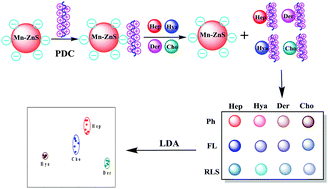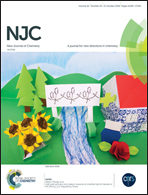Single-sensing-unit 3D quantum dot sensors for the identification and differentiation of mucopolysaccharides†
Abstract
A majority of traditional array sensors combine several sensing units, which can hardly be miniaturized. In order to solve the deficiency, it is suggested to design a sensing unit, which can obtain multidimensional information. Herein, taking the three-dimensional (3D) optical properties including phosphorescence (Ph), fluorescence (FL) and resonance light scattering (RLS) of the Mn–ZnS quantum dots (QDs) as signals, single-unit 3-signal mucopolysaccharide (MPS) sensors on the basis of Mn–ZnS QD/poly(diallyldimethylammonium chloride) (PDC) nanohybrids (Mn–ZnS+ QDs) were built with positively-charged poly(diallyldimethylammonium chloride) (PDC) as a receptor. These 3D sensors took advantage of the static interactional difference between Mn–ZnS+ QDs and different mucopolysaccharides (MPSs), and utilized different responses of Ph, FL and RLS to differentiate and identify four MPSs including heparan sulfate (Hep), hyaluronic acid (Hya), dermatan sulfate (Der) and chondroitin sulfate (Cho). Since the static interactional difference can be discriminated in virtue of the linear discriminating analysis, single-unit 3D sensors were constructed for differentiating MPSs of different types and concentrations. The three-dimensional sensor can still identify and analyze the target mucopolysaccharide in the presence of biological sample matrix, showing its good application prospects.



 Please wait while we load your content...
Please wait while we load your content...